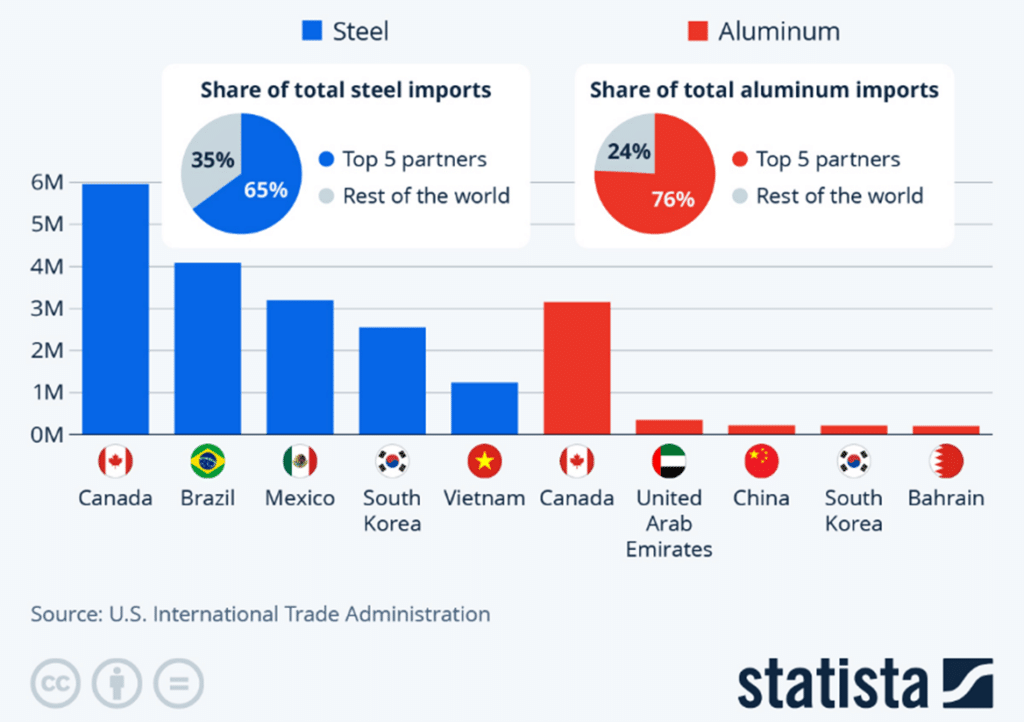
A Young Canadian Perspective: Energy in Everyday Life
Before diving deep, it’s important to start with the basics. Energy, by definition, is the ability to do work. It’s the foundation of modern civilization, it enables us to manipulate

*This story is evolving as global news continues to shift rapidly in today’s world.*
Earlier in February, U.S. President Donald Trump made a big move by signing an executive order that slapped a 25% tariff on steel and aluminum imports into the United States. The tariff took effect on March 12. This decision doesn’t just shake up global trade—it also scraps duty-free quotas for some of the U.S.’s closest trading partners, including Canada, which happens to be the largest supplier of these materials to the States.
The steel and aluminum industries are huge job creators, supporting thousands of workers, especially in provinces like Ontario and Quebec—home to tons of young Canadians building their careers. If these tariffs lead to job losses or economic instability, it could hit young people hard, directly affecting their job prospects and financial futures. It’s a situation worth keeping an eye on, especially for those of us thinking about the next generation of workers and the industries they rely on.

Did you know half of the U.S.’s aluminum is mostly imported from Canada? Trade policies, often shaped by politics, impact jobs, prices, and daily life—something young Canadians should watch closely. It’s not just Trump; presidents like Biden, Bush, Carter, and Reagan have also implemented steel tariffs. Why? Swing states.
Their key industries, like steel and aluminum, influence trade decisions, making tariffs a tool for political stability. For Canada, these policies ripple through our economy, affecting industries and livelihoods. Understanding this connection helps us see how global trade decisions hit home—and why we need to stay informed and proactive.
Trump’s tariff threats have already sent shockwaves through financial markets, shaken consumer confidence, and created an atmosphere of uncertainty for businesses. This uncertainty could delay hiring and investments. And when you look at the numbers, it’s clear how deeply connected Canada and the U.S. are.
The U.S. accounts for 49% of Canada’s total imports and is also our main supplier of agricultural goods. This means that tariffs will not only affect Canada’s industrial development such as the automobile industry, but it will also affect the food and agriculture industry like cereals, salmon, fruits, vegetables and juices. This means the cost of living will be further increased.
While these tariffs are definitely a challenge, they also present an opportunity for Canada to rethink how we approach trade and innovation. Right now, the tariffs make Canadian steel and aluminum less competitive in the U.S. market, which could hurt industries that rely on these materials.
But here’s the silver lining: this could push Canada to focus on producing higher-value finished goods, like automotive parts, aerospace components, or construction materials, making them less competitive, particularly in industries reliant on steel and aluminum production.
Companies might shift their focus away from aluminum and steel production if tariffs make these industries less profitable.

And let’s not forget, this isn’t the first time we’ve been here. Back in 2018, when the U.S. slapped tariffs on Canada, we hit back with $12.5 billion in tariffs on U.S. goods like ketchup, orange juice, toilet paper, and mayonnaise—products mainly made in swing states. It was a strategic move, and it showed that Canada isn’t afraid to stand up for itself.
Think about it—instead of just exporting raw materials, we could create more jobs and add more value to our natural resources. This shift could make our economy more resilient and open up new opportunities for young Canadians. By investing in research and development, automation, and green technologies, we can support industries affected by tariffs and position ourselves as global leaders in innovation.
For example, the push for electric vehicles is already gaining momentum, with government incentives like car purchase subsidies and investments in charging infrastructure. As global demand for EVs grows, these policies could help Canadian automakers thrive in 2024-2025, creating even more jobs for young Canadians.
Understanding the impact of tariffs and trade disputes can inspire young Canadians to think about how Canada can build a more resilient economy through innovation, diversification or stronger trade agreements. Canada can turn this moment of change into a foundation for long-term success. For our generation, this means more opportunities, a stronger economy, and a chance to lead on the global stage.
Sign up for updates about our work at YCR. Please sign up using a personal email and not a work or school email if possible.
"*" indicates required fields

Before diving deep, it’s important to start with the basics. Energy, by definition, is the ability to do work. It’s the foundation of modern civilization, it enables us to manipulate

Paying for energy nowadays feels, let’s be honest, like working a full-time job in and of itself. Winter heating your house and the gas consumed to go to and from

Today, we’re seeing a powerful shift: Indigenous leadership is increasingly at the forefront of natural resource and energy projects, especially in the liquefied natural gas (LNG) sector- reclaiming control, creating